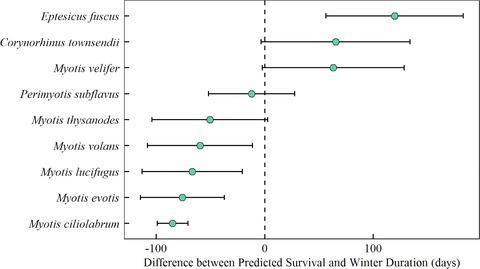当前位置:
X-MOL 学术
›
Ecol. Evol.
›
论文详情
Our official English website, www.x-mol.net, welcomes your
feedback! (Note: you will need to create a separate account there.)
Body mass and hibernation microclimate may predict bat susceptibility to white‐nose syndrome
Ecology and Evolution ( IF 2.3 ) Pub Date : 2020-12-21 , DOI: 10.1002/ece3.7070 Catherine G Haase 1, 2 , Nathan W Fuller 3, 4 , Yvonne A Dzal 5 , C Reed Hranac 6 , David T S Hayman 6 , Cori L Lausen 7 , Kirk A Silas 8 , Sarah H Olson 8 , Raina K Plowright 1
Ecology and Evolution ( IF 2.3 ) Pub Date : 2020-12-21 , DOI: 10.1002/ece3.7070 Catherine G Haase 1, 2 , Nathan W Fuller 3, 4 , Yvonne A Dzal 5 , C Reed Hranac 6 , David T S Hayman 6 , Cori L Lausen 7 , Kirk A Silas 8 , Sarah H Olson 8 , Raina K Plowright 1
Affiliation

|
In multihost disease systems, differences in mortality between species may reflect variation in host physiology, morphology, and behavior. In systems where the pathogen can persist in the environment, microclimate conditions, and the adaptation of the host to these conditions, may also impact mortality. White‐nose syndrome (WNS) is an emerging disease of hibernating bats caused by an environmentally persistent fungus, Pseudogymnoascus destructans. We assessed the effects of body mass, torpid metabolic rate, evaporative water loss, and hibernaculum temperature and water vapor deficit on predicted overwinter survival of bats infected by P. destructans. We used a hibernation energetics model in an individual‐based model framework to predict the probability of survival of nine bat species at eight sampling sites across North America. The model predicts time until fat exhaustion as a function of species‐specific host characteristics, hibernaculum microclimate, and fungal growth. We fit a linear model to determine relationships with each variable and predicted survival and semipartial correlation coefficients to determine the major drivers in variation in bat survival. We found host body mass and hibernaculum water vapor deficit explained over half of the variation in survival with WNS across species. As previous work on the interplay between host and pathogen physiology and the environment has focused on species with narrow microclimate preferences, our view on this relationship is limited. Our results highlight some key predictors of interspecific survival among western bat species and provide a framework to assess impacts of WNS as the fungus continues to spread into western North America.
中文翻译:

体重和冬眠小气候可能预测蝙蝠对白鼻综合症的易感性
在多宿主疾病系统中,物种间死亡率的差异可能反映了宿主生理、形态和行为的差异。在病原体可以在环境中持续存在的系统中,小气候条件以及宿主对这些条件的适应也可能会影响死亡率。白鼻综合症(WNS)是一种新出现的冬眠蝙蝠疾病,由环境持久性真菌破坏假裸囊菌引起。我们评估了体重、迟钝的代谢率、蒸发失水以及冬眠温度和水蒸气缺乏对受破坏性腐霉感染的蝙蝠的预测越冬存活率的影响。我们在基于个体的模型框架中使用冬眠能量学模型来预测北美八个采样点的九种蝙蝠的生存概率。该模型根据物种特异性宿主特征、冬眠微气候和真菌生长来预测脂肪耗尽的时间。我们拟合线性模型来确定与每个变量的关系,并预测生存和半偏相关系数,以确定蝙蝠生存变化的主要驱动因素。我们发现宿主体重和冬眠水蒸气缺乏解释了跨物种 WNS 生存差异的一半以上。由于之前关于宿主和病原体生理学与环境之间相互作用的研究主要集中在具有狭窄小气候偏好的物种,因此我们对这种关系的看法是有限的。我们的研究结果强调了西部蝙蝠物种种间生存的一些关键预测因素,并提供了一个框架来评估随着真菌继续扩散到北美西部,WNS 的影响。
更新日期:2021-01-08
中文翻译:

体重和冬眠小气候可能预测蝙蝠对白鼻综合症的易感性
在多宿主疾病系统中,物种间死亡率的差异可能反映了宿主生理、形态和行为的差异。在病原体可以在环境中持续存在的系统中,小气候条件以及宿主对这些条件的适应也可能会影响死亡率。白鼻综合症(WNS)是一种新出现的冬眠蝙蝠疾病,由环境持久性真菌破坏假裸囊菌引起。我们评估了体重、迟钝的代谢率、蒸发失水以及冬眠温度和水蒸气缺乏对受破坏性腐霉感染的蝙蝠的预测越冬存活率的影响。我们在基于个体的模型框架中使用冬眠能量学模型来预测北美八个采样点的九种蝙蝠的生存概率。该模型根据物种特异性宿主特征、冬眠微气候和真菌生长来预测脂肪耗尽的时间。我们拟合线性模型来确定与每个变量的关系,并预测生存和半偏相关系数,以确定蝙蝠生存变化的主要驱动因素。我们发现宿主体重和冬眠水蒸气缺乏解释了跨物种 WNS 生存差异的一半以上。由于之前关于宿主和病原体生理学与环境之间相互作用的研究主要集中在具有狭窄小气候偏好的物种,因此我们对这种关系的看法是有限的。我们的研究结果强调了西部蝙蝠物种种间生存的一些关键预测因素,并提供了一个框架来评估随着真菌继续扩散到北美西部,WNS 的影响。











































 京公网安备 11010802027423号
京公网安备 11010802027423号